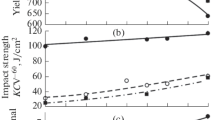Conclusions
-
1.
Chrominum-nickel-molybdenum steel tempered at high temperatures has the minimum embrittlement temperature when the steel has a martensitic structure after quenching.
-
2.
The higher the degree of decomposition of austenite in the pearlite and troostite range of temperatures, the higher the temperature of embrittlement.
-
3.
The increases of the quenching temperature above the Ac3 point increases the embrittlement temperature.
-
4.
Quenching in a heated medium increases the embrittlement temperature in all cases if the austenite decomposes and forms troostite or pearlite.
-
5.
The increase of the tempering temperature decreases the embrittlement temperature.
Similar content being viewed by others
Author information
Authors and Affiliations
Additional information
Translated from Metallovedenie i Termicheskaya Obrabotka Metallov. No. 1, pp. 57–58, January, 1964
Rights and permissions
About this article
Cite this article
Kofman, A.P., Grebenshchikov, V.G. Susceptibility of 30Kh2N4M and 30Kh2N2M steels to embrittlement at low temperatures. Met Sci Heat Treat 6, 49–51 (1964). https://doi.org/10.1007/BF00661976
Issue Date:
DOI: https://doi.org/10.1007/BF00661976




